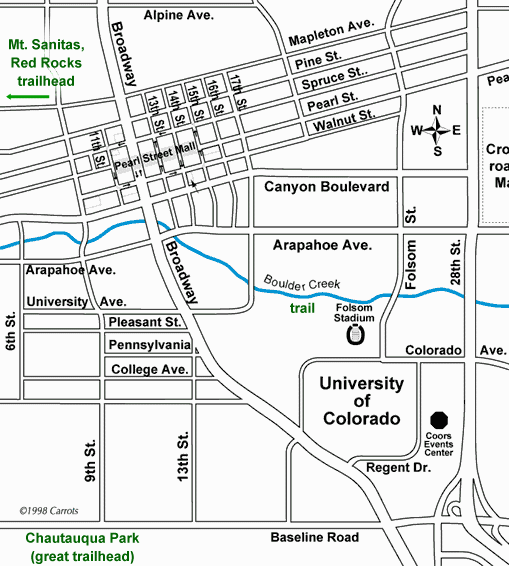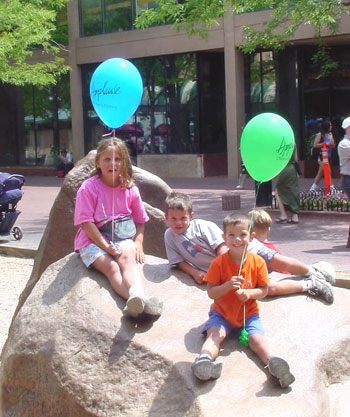
Background
In the 1960's as shopping malls were springing up across the country, a group of forward-thinking citizens owning property and working in downtown Boulder began to look for ways to keep the historic center of the City of Boulder attractive and economically sound. In 1966, the Boulder Committee for the Exploration of Core Area Potential (CECAP) was formed. The group consisted of mostly city officials and downtown property owners, but felt it vital to have citizens participate in all aspects of the planning process and opened the membership to all interested persons.
Later that year, the group changed its name to Boulder Tomorrow and with the assistance of Sally Irwin, who became the volunteer Director, began a two-phase downtown improvement plan. The first phase sought support both in planning and fund raising. Phase One facilitated the move to Phase Two, a plan and proposal for Downtown development. Two downtown plans were eventually rejected due to cost, but the second, developed by the Boulder architectural firm of Carl Worthington Partnership proposed a four-block pedestrian mall on Pearl Street – a concept that was eventually adopted and designed by the firms Sasaki & Associates and Communication Arts.
In 1970, Governor John Love signed the Public Mall Act into law. Among other things, the law allowed Colorado cities to close downtown streets in order to build pedestrian malls and detailed the suitable methods of financing such projects.
Assembling funding to build the Mall became a cooperative effort. A Mall Assessment District was formed. The City of Boulder applied for and received a $650,000 federal grant from the 1974 Community Housing and Development Act, or 1/3rd of the cost. Property owners assessed themselves $1.2 million in a graduated system, or 2/3rd's of the cost needed to build the four block, brick-paved pedestrian mall.
On June 12, 1976, Pearl Street was closed between 11th and 15th Streets. The completed mall was dedicated on August 6, 1977. The Mall has been called the “crown jewel” of Boulder.
Adapted From: City of Boulder “History of the Downtown Boulder Area”
Design Concept and Interventions
Interview with Richard Foy, Principle, Communication Arts (now part of Stantec):
- The idea to build a child-friendly environment came from CommArts. We wanted to create a space that signaled to kids that it was a place to play and be animated.
- There are three major play elements that are part of the Pearl Street Mall:
- Boulders: There are smooth river rocks for kids to play, sit, and slide on, ranging from 12 inches to four feet high. They are appropriate sizes for toddlers to 12 year-olds. The boulders sit in a recessed area filled with sand. Parents will sit on the step and watch their kids. Also in this area are tube structures that kids can climb through.
- Four whimsical statues of a snail (marble), frog (bronze), rabbit (marble), and beaver (bronze), are included, which are all animals found in the local environment. They all have soft edges so kids can easily climb on them. There are no protrusions that can be vandalized. The statues sit in beds of gravel, which was chosen because kids would pick up and throw stones. Sand would get tracked into businesses.
- The pop-jet fountain is very popular in the summertime. Toddlers love it. Parents will bring their kids and a towel to play in the fountain.
- The mall originally had a grassy area, but it was taken out on the 25th year anniversary of the mall. It attracted college students who would lounge with shirts off and play Frisbee. The grass just got trampled and the college students were deemed not good for business. In its place, they installed a large fountain made out of Colorado flagstone. Kids can run their hands through the water.
- Another popular element with kids and adults alike is a giant boulder that has been split in half. People can walk between the two halves and be able to hear the “spirit of the rocks.”
- According to Foy, “Slides and swings are suburban. We wanted to create an urban experience.”
Each block of the mall has a major child-oriented amenity.
Reception by the Community
Interview with Eli Madrone, Downtown Boulder Business Improvement District:
- Children’s amenities bring business to the pedestrian mall.
- Core demographic of the local businesses is young and middle-aged mothers, who bring their kids to play and then do some shopping while they are there. It is very much a destination for this demographic as well as for other residents from the surrounding neighborhoods.
- The Mall is walking distance from residential neighborhoods as well as the local university.
Interview with Molly Winter, Boulder Parking District:
- The Pearl Street Mall is completely embraced by the community. It is a major icon for the city.
- The mall is considered an urban park, so it is maintained by the city parks department.
- The boulder sand box would not be allowed to be built today because the boulders are too close together for health standards – a child could fall off one boulder and hit his/her head on another one.
Lessons Learned
Potential Benefits:
- Provide pedestrian-only streets.
- Include public art, such as interactive structures.
- Increase business at nearby businesses.
- Have a specific policy toward creating child-friendly spaces.
Potential Issues:
- Initial merchants’ fears that taking away parking will be harmful to business must be addressed.
- The responsibility for maintaining facilities must be determined.
- Cost is a issue.
- A pedestrian mall is most appropriate on commercial streets.
Sources
City of Boulder “History of the Downtown Boulder Area” (http://www.bouldercolorado.gov/index.php?option=com_content&task=view&id=3394&Itemid=1034)
Interviews
Eli Madrone, Downtown Boulder Business Improvement District
Richard Foy, Principle, Communication Arts (now part of Stantec)
Molly Winter, Boulder Parking District
Photo Sources
MIG, Inc.


